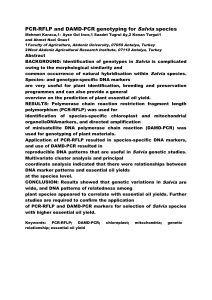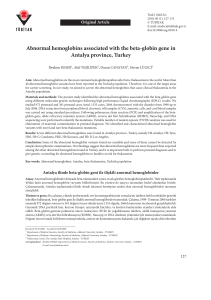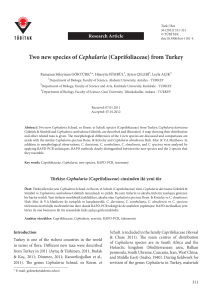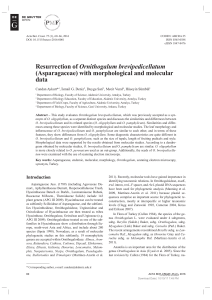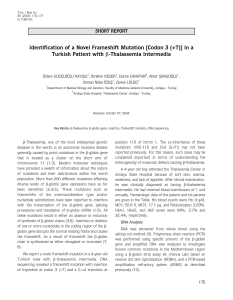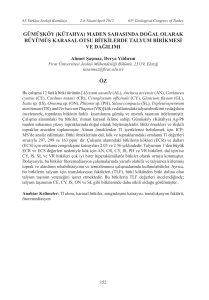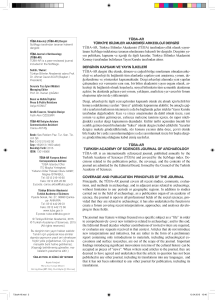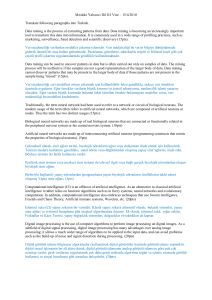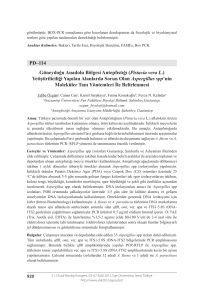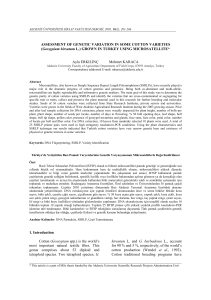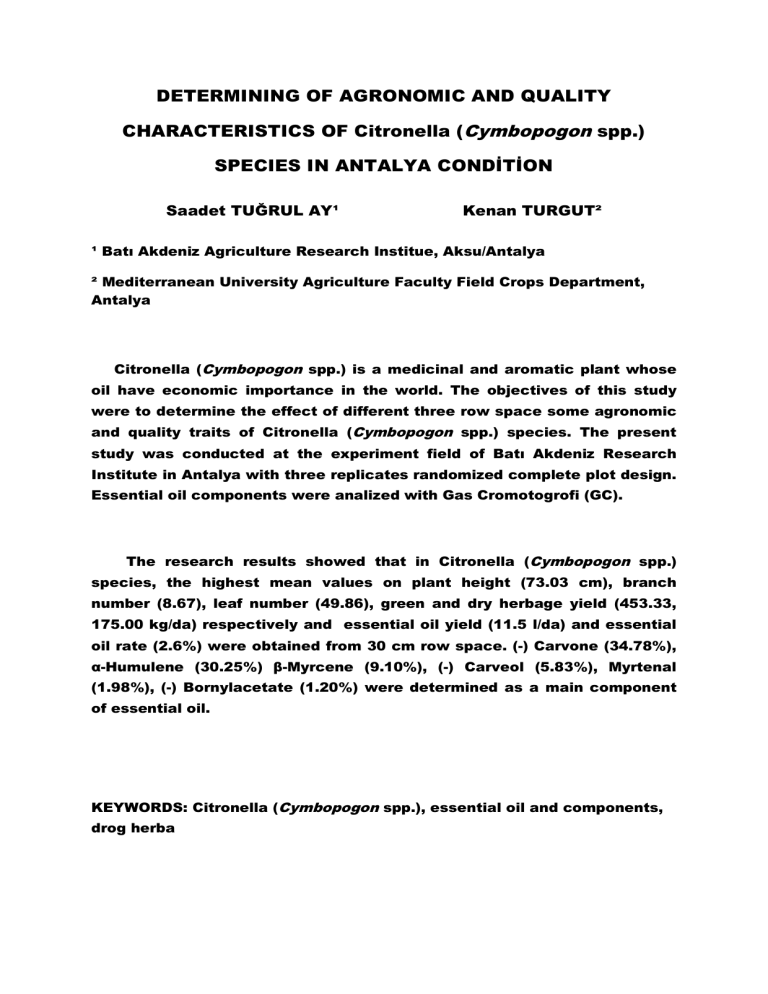
DETERMINING OF AGRONOMIC AND QUALITY
CHARACTERISTICS OF Citronella (Cymbopogon spp.)
SPECIES IN ANTALYA CONDÝTÝON
Saadet TUÐRUL AY¹
Kenan TURGUT²
¹ Batý Akdeniz Agriculture Research Institue, Aksu/Antalya
² Mediterranean University Agriculture Faculty Field Crops Department,
Antalya
Citronella (Cymbopogon spp.) is a medicinal and aromatic plant whose
oil have economic importance in the world. The objectives of this study
were to determine the effect of different three row space some agronomic
and quality traits of Citronella (Cymbopogon spp.) species. The present
study was conducted at the experiment field of Batý Akdeniz Research
Institute in Antalya with three replicates randomized complete plot design.
Essential oil components were analized with Gas Cromotogrofi (GC).
The research results showed that in Citronella (Cymbopogon spp.)
species, the highest mean values on plant height (73.03 cm), branch
number (8.67), leaf number (49.86), green and dry herbage yield (453.33,
175.00 kg/da) respectively and essential oil yield (11.5 l/da) and essential
oil rate (2.6%) were obtained from 30 cm row space. (-) Carvone (34.78%),
á-Humulene (30.25%) â-Myrcene (9.10%), (-) Carveol (5.83%), Myrtenal
(1.98%), (-) Bornylacetate (1.20%) were determined as a main component
of essential oil.
KEYWORDS: Citronella (Cymbopogon spp.), essential oil and components,
drog herba
DETERMINING OF AGRONOMIC AND QUALITY
CHARACTERISTICS OF Phlomis lycia SPECIES IN THE
FLORA OF ANTALYA
Saadet TUÐRUL AY¹ Kenan TURGUT²
Orhan Ünal³ Ramazan Göktürk³
¹ Batý Akdeniz Agriculture Research Institue, Aksu/Antalya
² Mediterranean University Agriculture Faculty Field Crops Department,
Antalya
³ Mediterranean University Biyology Department, Antalya
The objectives of this study were to determine some agronomic and
quality traits of Phlomis lycia (Jerusalem sage) species collected from the
flora of Antalya. The present study was conducted at the experiment field
of Batý Akdeniz Research Institute in Antalya with three replicates
randomized complete plot design. Essential oil components were analized
with Gas Cromotogrofi (GC).
The research results showed that in Phlomis lycia, the highest mean
values on plant height (63.07 cm), branch number (21.60), green and dry
herbage yield (1330.33, 676.00 kg/da) respectively and essential oil yield
(14.2 l/da) were determined. The essential oil rate in wild (2.2%) and in
field experiment (2.1%) at flores stage were obtained. Main components of
Borneol (18.0%) and Cineole (15.6%) at flores stage from field experiment
were obtained. From native,
main components of Cineole (18.3%) and
Borneol (16.3%) at flores stage were determined.
KEYWORDS: Phlomis lycia, essential oil and components, drog herbage
Essential Oil Content and Composition of Oregano
(Origanum spp.) Species grown in Native and Field
Conditions of Antalya
Saadet TUÐRUL AY¹
Kenan TURGUT²
¹ Batý Akdeniz Agriculture Research Institue, Antalya, Turkey
² Akdeniz University, Faculty of Agriculture, Department of Field Crops,
Antalya, Turkey
The objectives of this study were to determine variability of essential
oil content and composition of five oregano species (Origanum saccatum,
O. solymicum, O .majorana, O. onites and O. vulgare subsp. hirtum)
collected from the flora of Antalya. Essential oil components were
determined
before
inflorescences,
during
inflorescences
and
after
inflorescences of species grown in wild and field conditions. They were
analyzed with Gas Cromotogrofi (GC). The highest essential oil rate were
obtained from native O. majorana (%8.2) which
was harvested during
inflorescences and followed by field grown O. onites (%5.2). Eighteen
compounds were identified in the essential oil of oregano species under
studied conditions. In the field grown plants. Carvacrol which is a main
component
in
oregano
was
found
56.90%
in
O.
majorana
before
inflorescences, 42.90% in O. saccatum, 39.90% in O.vulgare subsp. hirtum,
29.20% in O. solymicum during inflorescences stage. Another main
component, Linalool was found 80.90% in O. onites after inflorescences of
field grown plants. In the native plants, Carvacrol was found as followed ;
O. saccatum (34.20%) before inflorescences stage, O. majorana (52.40%),
O. onites (31.80%) and
O. vulgare subsp. hirtum (39.50%) during
inflorescences. Native O. solymicum contains Linalool (20.10%) and
Thymol (19.80%) as the main components. Essential oil components
showed great variations within the species as well.
Keywords: Oregano (Origanum spp.), essential oil and components
FARKLI BÝTKÝ SIKLIÐININ REYHAN (Ocimum basilicum) ’nýn VERÝM VE
KALÝTE ÖZELLÝKLERÝ ÜZERÝNE ETKÝLERÝ
Saadet TUÐRUL AY¹
Kenan TURGUT²
Esra UÇAR ²
¹ [email protected], Batý Akdeniz Tarýmsal Araºtýrma Enstitüsü, ANTALYA
² Akdeniz Üniversitesi Ziraat Fakültesi Tarla Bitkileri Bölümü, ANTALYA
² [email protected], Akdeniz Üniversitesi Ziraat Fakültesi Tarla Bitkileri
Bölümü, ANTALYA
Özet: Antalya koºullarýnda yetiºtirilen reyhan (Ocimum basilicum) bitkisinde,
farklý bitki sýklýðýnýn çiçeklenme ve çiçeklenme sonrasý dönemlerde yeºil herba
(kg/da), drog herba (kg/da) verimine, çiçeklenme döneminde bitki boyu (cm), uçucu
yað oraný ve bileºenlerine (%) etkilerinin belirlenmesi amaçlanmýºtýr.
Deneme,
Batý Akdeniz Tarýmsal Araºtýrma Enstitüsü deneme alanýnda 2003 yýlýnda, tesadüf
bloklarý deneme desenine göre 30, 40, 50 cm sýra arasý mesafeler kullanýlarak üç
tekrarlamalý kurulmuºtur. Materyal olarak, bölgede yetiºtirilen populasyonlarýn
tohumlarý kullanýlmýºtýr. Çiçeklenme döneminde, farklý sýra arasý mesafenin bitki
boyu, taze ve kuru herba verimi üzerine etkilerinin istatistiki olarak önemli olduðu
tespit edilmiºtir. En yüksek, 40 cm sýra arasý mesafede bitki boyu (46.93 cm), taze
herba verimi (1813 kg/da) ve kuru herba verimi (353.3 kg/da) deðerleri elde
edilmiºtir. Farklý sýra arasý mesafenin uçucu yað oraný üzerine etkisinin istatistiki
olarak önemli olmadýðý belirlenmiºtir. Yapýlan içerik analizinde en yüksek Linalool
(%46), á-Terpinen (%16), Borneol (%4.4) ve Linalyl acetat (%4.4), â-Myrecene
(%2.1),
Thymol
(%1.7),
Camphor
(%1.4)
olarak
bulunmuºtur.
Veriler
deðerlendirildiðinde, Antalya koºullarýnda 40 cm sýra arasý mesafenin tarýmý için
uygun olabileceði söylenebilir.
Anahtar Kelimeler: Reyhan (Ocimum basilicum), verim, uçucu yað
Abstract: The objectives of this study were to determine different plant density
green and dry herbage yield (kg/da) at flores stage and after flores stage, plant
length (cm), essential oil rate (%) and components at flores stage. The present
study was conducted at the experiment field of Batý Akdeniz Research Institute in
Antalya in 2003 with three replicates randomized complete plot design and was
use 30, 40, 50 cm row space. Plant height, green and dry herbage were statistical
significant at different row space. The highest mean plant height (46.9 cm), green
(1813.3 kg/da) and dry (353.3 kg/da) herbage yield were obtained at 40 cm row
space. Essential oil rate was not statistical significant at different row space.
Linalool (%46), á-Terpinen (%16), Borneol (%4.4) ve Linalyl acetat (%4.4), âMyrecene (%2.1), Thymol (%1.7), Camphor (%1.4) were obtained at flores stage. 40
cm row space can be cultivated in Antalya conditions.
Key words: Basil (Ocimum basilicum), yield, essential oil
ANTALYA FLORASI’NDA YAYGIN OLARAK BULUNAN
Salvia tomentosa TÜRÜNDE FARKLI LOKASYONLARIN
KÖKLENDÝRME ÜZERÝNE ETKÝLERÝ
Saadet TUÐRUL AY¹
Esra UÇAR ²
Kenan TURGUT²
¹[email protected], Batý Akdeniz Tarýmsal Araºtýrma Enstitüsü,
ANTALYA
² Akdeniz Üniversitesi Ziraat Fakültesi Tarla Bitkileri Bölümü, ANTALYA
² [email protected], Akdeniz Üniversitesi Ziraat Fakültesi Tarla
Bitkileri Bölümü, ANTALYA
Özet:Antalya florasýnda oldukça yaygýn olarak bulunan Salvia tomentosa
türünün 3000 ppm IBA dozunda yedi farklý lokasyonun köklenme durumlarý
üzerine etkileri araºtýrýlmýºtýr. Deneme Batý Akdeniz Tarýmsal Araºtýrma
Enstitüsü
serasýnda
(adet/çelik),
kök
yapýlmýºtýr.
uzunluðu
(cm)
Köklenme
özellikleri
oraný
(%),
kök
incelenmiºtir.En
sayýsý
yüksek
köklenme oraný (%100) olarak 2’inci (Kemer-Kesme Boðazý, 1212 m) ve 5.
lokasyonlardan (Akseki-Ýbradý köyü, 242 m) elde edilmiºtir. Kök sayýsý
üzerinde farklý lokasyonlarýn etkileri istatistiki olarak önemli bulunmuºtur.
En yüksek ortalama deðeri
2’inci (Kemer-Kesme Boðazý, 1212 m)
lokasyondan 13.3 adet/çelik olarak belirlenmiºtir. Kök uzunluðu istatistiki
olarak
önemli
bulunmamýºtýr,
en
lokasyondan 5.9 cm elde edilmiºtir.
yüksek
ortalama
deðeri
2’inci
Anahtar Kelimeler: Salvia tomentosa,IBA, köklenme, çoðaltma
Abstract: Salvia tomentosa is widespread grown plants in Antalya flore. The
propagation possibilities of the species by stem cuttings were investigated
at 3000 ppm IBA dose. The study was conducted at the experiment gren
house of Batý Akdeniz Research Institute. Rooting ratio (%), root lenght
(cm), root number (number/cutting) and rooting quality of cuttings were
measured. The highest rooting ratio (%100) obtained from Kemer-Kesme
boðazý (1212 m) and Akseki-Ýbradý (242 m) locations. The highest mean
values of root number ( 13.3 number/cutting) and root lenght (5.9 cm)were
obtained from Kemer-Kesme boðazý (1212 m). Root lenght was not
statistical significant.
Key words: Salvia tomentosa, IBA, rooting, propagation
ROOTING PERFORMANCE OF SOME AROMATICAL PLANTS
FROM LAMIACEAE
TUÐRUL AY S., UÇAR E., TURGUT K.
¹ Batý Akdeniz Agriculture Research Institue, Antalya, Turkey
² Akdeniz University, Faculty of Agriculture, Department of Field Crops,
Antalya, Turkey
This study was carried out at the greehouses of department of
BATEM to determine how the IBA treatment effected rooting
duration of the cuttings of 10 species of Origanum, 6 species of
Salvia, 4 species of Thymus, 3 species of Satureja, 1 species of
Teucrium and 1 species of Doristatis. The experiment was arranged
as randomised plot design with 3 replications. Before planting the
cuttings are solaced by Iba solutions (Thymus spp. 2000 ppm, the
others 3000 ppm) for 5 seconds. According to results obtained from
experiments number of root was changed between 1 to 33,03 and
root lenght was changed between 0.50 to 6,70 cm. The highest root
number and the longest root lenght was obtained from Salvia
fruticosa and the lowest root number and shortest root lenght was
obtained from Satureja thymbrah.
Keywords: Aromatical plants, root lenght, root nunber, IBA
A CTAB-BASED DNA EXTRACTION PROTOCOL FOR LABIATAE SPECIES
M. KARACA¹, S. TUÐRUL AY², K.TURGUT¹
¹Akdeniz University, Faculty of Agriculture, Department of Field Crops,
Antalya, Turkey
² Batý Akdeniz Agriculture Research Institue, Antalya, Turkey
A CTAB-based DNA extraction protokol is described to obtain large scale,
high molecular weight, restrictable and amplifiable nuclear, mitochondrial
and chloplast DNAs from several LABIATAE species widely grown in the
Mediterranean region of Turkey. Spectrophotometer, restriction enzym
digestions and PCR analyses along with agarose gel separation studies
confirmed that large scale, high molecular weight and restrictable DNAs
were obtained. Mean of the extracted total DNA was 673.2 ìg/g ranging
from 510 to 1410 ìg/g across the 31 samples belong to 14 genus. Coisolotion of genomic and organelle DNAs were also confirmed using
organelle and nuclear DNA specific primers. Suitability of the extraction
method for DNA fingerprinting techniques such as RAPD, SSRLP, DAMD
and PCR-RFLP was confirmed. This DNA extraction method might be useful
for direct comparison, classification and molecular mapping of LABIATAE
species.
Keywords: Labiatae, Chloroplast, mitochondria,nuclear, RAPD,DAMD,PCRRFLP,SSR
DEVELOPMENT OF SPECIES SPECIFIC DNA MARKERS IN
SALVIA SPP.
AHU Y. ÇINAR¹, AYªE GÜL ÝNCE, SAFÝNAZ Y. ELMASULU¹, SAADET T. AY,
MEHMET KARACA¹
¹Akdeniz University, Faculty of Agriculture, Department of Field Crops, Antalya,
Turkey
² Akdeniz University, Faculty of Agriculture, Department of Horticulture, Antalya,
Turkey
³ Batý Akdeniz Agriculture Research Institue, Antalya, Turkey
Aromatic plant species have been used for thousands of years for
medicinal, aromatic, fungicide, insecticide and bactericide properties. Due
to these properties many medicinal and aromatic plant species are
undergoing domestication and cultivar development. Salvia is large group
perennials, annuals and shrubs found wild in Turkey by 94 taxa belonging
to 89 species with 50% endemism. DNA tecnologies have been safely used
in species identification and many other purposes. In this study we studied
chloroplast DNAs (cpDNA) and mitochondrial DNAs (mtDNAs) in 7 different
Salvia spp. And a control. Plant samples were collected natural growing
areas in the Mediterranean Basin of Turkey and grown in experimental
fields of Batý Akdeniz Agriculture Research Institue, Antalya, Turkey.
Research used Polymerase Chain Reaction-Restriction Fragment Lenght
Polymorphism (PCR-RFLP) to identify species cpDNAs or mtDNAs that
would provide valuable information in taxonomy, phytochemistry molecular
ecology, domestication and agronomical studies of Salvia spp.. This study
initially utilized 7 choloplast and 7 mitochondria gene specific primer pairs
and 4 restriction endonucleases. We identifed that the use of 2 chloroplast
specific gene primer pairs plus 2 restriction endonuclease enzymes could
differentiate all the samples used. We determined genetic relationships
among the Salvia
spp. Using UPGMA and Neighbor-Joining methods.
Results indicated that among the organelle genomes within the Salvia spp.
Chloroplast DNA makeup differed in comparison to the that of the
mitochondria. Overall, results demostrated that PCR-RFLP technique is a
powerful and reliable method to differentiate and determine the genetic
relationshipsin Salvia species.
Keywords: Chloroplast, DNA markers, Genetic relationship, Mitochondria and
Phylogeny

